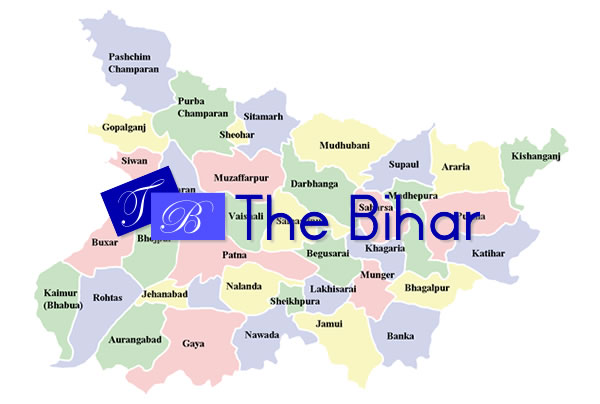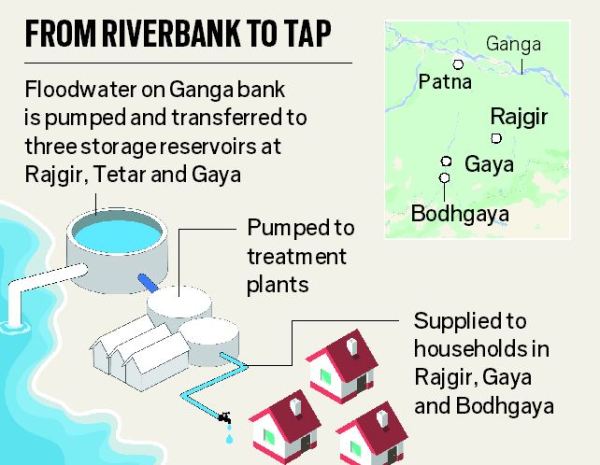Bhagalpur
6 min readBhagalpur is a city and municipal corporation in the Bihar state of Eastern India. Bhagalpur is one of the oldest districts of Bihar located in the Southern region. It is situated in the plane of the Ganga basin at the height of 141 feet above sea level. It covers an area of 2569.50 sq. km. and lies between 25o-07′ – 25o30′ N Latitude and between 86o 37 ‘ – 87o 30 ‘E Longitude. It is the administrative headquarters of the Bhagalpur District. Bhagalpur is acclaimed the world over for its silk products and it is known in India as the “Silk City”. Bhagalpur is the distorted form of Bhagdatpuram as it was called during the apex of Anga Kingdom and has been the seat of power since.
Overview
Bhagalpur is a divisional town of historical importance situated on the southern bank of the Ganga river. Situated 220 km east of Patna, the state capital of Bihar, and 410 km north west of Calcutta. The city was referred to as one of the biggest trade centers in eastern India by the 7th century Chinese travellers Hiuen Tsang and Fa Hien. The city had a big harbour on the Ganges River at place called Champanagar (another name for Bhagalpur), now called Champanala, which flows on the western boundary of the present city near Nathnagar. During an archaeological excavation, many boats and coins of the Middle and Far East were found at the same place. Bhagalpur is well connected by rail and road. The airport at Bhagalpur was functional until the 1980s but since that time has awaited rejuvenation.
The city is famous worldwide for its silk and mango production. The silk industry in this city is hundreds of years old and its inhabitants have been producing silk for generations. There is a Silk Institute and Agricultural college here, as well as a University, and Engineering, Medical and Homoeopathic colleges.
The gangetic plains are very fertile and the main crops include rice, wheat, maize, barley, and oilseeds. The economy of Bhagalpur is dependent mainly on agriculture and small businesses.
History
Early civilizations have flourished along the fertile banks of the Ganges river. Bhagalpur has often been referred to as Bhagaddat-Puram in ancient Sanskrit literature such as the Ramayana, Mahabharatha and Panchtantra. The religious festival of “Vish-hari Puja” or “the worship of the snake queen” traces its roots back hundreds of years and is still celebrated every year with thousands of believers and snake charmers offering milk to the Nag (the snake King) and Nageen (The snake Queen).
References to Bhagalpur can be found in Indian epics like the Ramayana and the Mahabharata where Bhagalpur has been described as the kingdom of Anga. Ancient cave sculptures of Emperor Ashoka’s regime (274 BC-232 BC) are found in the neighbourhood and at Sultangunj, 20 km west of Bhagalpur, a temple of the Gupta period (320-500) still exists. The tomb of Suja, brother of Moghul emperor Aurangzeb, in the heart of the town is reminiscent of the city’s association with the Mughal period.
The ruins of ancient Vikramshila University are located 44 km east of Bhagalpur. The royal university of Vikramsila, ranks next to Nalanda and owes its origin to Dharmapala (770-810 A.D.), the devout Pala king who loved to call himself Paramasaugata (chief worshipper of the Buddha) and was a great patron of Mahayana Buddhism. It was the medieval center to the conservation and propagation of Buddhist education, established by King Dharampal of Bengal (783-820) at the end of the 8th century.
Bhagalpur formed a part of the ancient Sanskrit kingdom of Anga said to be ruled by king Karna of Mahabharata who was well known for his charity. In later times it was included in the powerful Hindu kingdom of Magadha or Behar, and in the 7th century it was an independent state, with the city of Champa as its capital. It afterwards formed a part of the Mohammedan Kingdom of Gaur, and was subsequently subjugated by Akbar, who declared it to be a part of the Delhi empire. Bhagalpur passed to the East India Company by the grant of the emperor Shah Alam II in 1765.
The first railway line from Howrah was built to pass through Bhagalpur: the East Indian Railway line to Bhagalpur opened in 1861.
Mythological significance of the most influential in “Aryavarta” or India of that time and was concurrent to Patliputra or Patna. Bhagdatpuram finds its mention in the Vedas and Ramayana as well. It is supposed to be the kingdom of Daanvir Karna “the son of Kunti from God Sun” and was called Ang Pradesh. The word Bhagalpur literally means ‘City of good luck.’
Mount Mandara , situated 52 km south from Bhagalpur, is believed to have been used as churner during Samudra-Manthan by God and Danava according to Hindu mythology. Mandar Hills steeped in legend and laced with landscape of extraordinary splendour exposes the 800 feet high granite hill. Mandar is associated with Samudra-Manthan which suggests that the hill was used by the gods to churn the ocean to procure amrit. The serpent, vasuki offered to serve as the rope and has left behind an impression of the coil on the granite hill. It is believed that panchjanya, the conch shell used in Mahabharat War was discovered here in the Sank kund. The puranas refer to various sacred places on the hill which is also believed to be the abode of Vishnu under the title of Madhusudana or the destroyer of a demon called Madhu who was killed by Vishnu and then covered by the Mandar hill. Kalidasa’s Kumarasambhava refers to foot marks of Vishnu on the slopes of Mandara. The hill is replete with relics of bygone ages. Besides inscriptions and statues there are numerous rock cut sculptures depicting various Brahmanical images. The hill is equally revered by the Jains who believe that their 12th Tirthankara attained nirvana here on the summit of the hill.
Demography
As of 2001 India census, Bhagalpur had a population of 340,349. Males constitute 54% of the population and females 46%. Bhagalpur has an average literacy rate of 68%, with 70% of the males and 62% of the females literate. 14% of the population is under 6 years of age. Bhagalpur is one of the leading education centers of Bihar.
Culture
Chhath Puja and Dussehra are the major festivals of Bhagalpur.
Language
The popular language spoken in Bhagalpur is Angika, a regional language which is reported to be spoken by 50 million people world wide. Hindi and English are the next most well known languages. Nearly 30% of the population speaks English, and half of these can speak with a high degree of fluency.
People from Bhagalpur
- Kadambini, daughter of Braja Kishore Bose, headmaster of Bhagalpur School, was one of the first women graduates in the British Empire and the first woman doctor in South Asia.
- Ashok Kumar, Kishore Kumar and Anup Kumar: These three most famous brothers of Hindi cinema, had spent most of their childhood in Adampur area in core of the city. Ashok Kumar known as the dada muni of Hindi cinema had done the entire schooling at the C.M.S. High school Bhagalpur. The city being their maternal grand parent’s home was a dear to all the three and Dada Muni was a regular to the city till his demise.
- Sharat Chandra Chattopadhyaya is known to have roots in the city. He had written his famous novel Devdas in Bhagalpur itself. He spent 20 years of his life in Bhagalpur and major parts of his novels were either written in Bhagalpur or based on his experience in Bhagalpur.
- Rabindra Nath Tagore occupied Tillha Kothi close to the University Campus for a considerable period. Parts of the nobel awarded Gitanjali was written in Tilla Kothi.
- Business Magnate Subroto Roy of the famous Sahara Parivar has spent part of his early life in Bhagalpur. He underwent his primary education in Bhagalpur’s C.M.S. High school.
- Suchitra Bhattacharya, acclaimed Indian novelist was born in Bhagalpur on 10 January 1950.
- Tilak Dhar Manjhi famous tribal who fought bravely against British.
Places of Interest
- Jain Temple (Champanagar)
- Kuppa Ghat (Bank of Ganga river)shabbir home
- Karna Garh (Nathnagar)
- The Old Post Office
- The Shiva Temple at Budhanath
- Rabindra Nath Bhavan(Tillha Kothi)
- The Residence of Sharat Chandra Chattopadhyaya
- Lajpat Park
- Sandy’s Compound
- Ghuran pir baba Vikramshila Setu
- Sanjay Gandhi Jaivik Udhyan
Universities
- Tilka Manjhi Bhagalpur University
Colleges
- Jawahar Lal Nehru Medical College & Hospital
- Bhagalpur College of Engineering
- Sabour Agriculture College
- T.N.B.College
- S.M.College
- Vimal Bibhuti College of Education
- Mahadev Singh College
- S.D.College
- J.V.College
- Sabour College
- Silk School Of Research & Development
- Bhagalpur Polytechnic
- Marwari College
Schools
- Mount Carmel School
- Mount Assisi School
- Saint Joseph’s School
- Saint Teresa’s School
- C.M.S High School
- Navyug Vidyalaya
- Delhi Public School
- D.A.V. Public School
- Christ Church Girls High School
- Saint Andrew’s School
- Zila School
- Saint Paul’s School
- T.N.B. Collegiate High School
- Marwari Pathshala
- Muslim High School
- Mirjanhat High School


